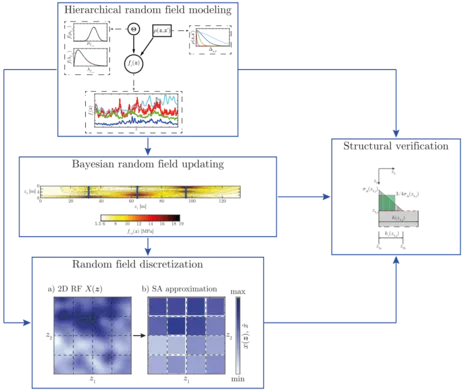Structural reliability analysis accounting for spatial variability and measurements
The assessment of engineering structures from a probabilistic point of view has gained importance in the field of civil engineering, especially for large structures or infrastructure systems. Potentially large reduction of costs together with an increased safety level justify the need for more extensive modeling and reliability analyses. At the moment, reliability analyses with probabilistic modeling are poorly standardized, which on the one hand increases the effort for the application and on the other hand leads to difficulties in the interpretation of the results. Although the current version of European design standards includes a concept for the design or recalculation of structures with probabilistic modeling, this concept is mostly used for research and future developments. The spatial variability of material properties can be explicitly modeled with random fields. Using a hierarchical approach, the uncertainty in the marginal parameters of a Gaussian random field is modeled with a normal-gamma distribution. This choice allows an analytical Bayesian update of the random field, if site-specific data is available, resulting in a non-homogeneous Student’s -random field. The spatial averaging method has been chosen as discretization method, as it is straightforward to apply and can easily be coupled with finite element models, which are often used for structural verification. The developed framework opens possibilities for the development of standardized verification formats with spatial variability. Depending on the verification case, the full random field, the discretized random field or only point-wise marginal distributions can enter the calculations, as illustrated in the figure above.

Researchers
Supervisors
Funding
Collaboration
- Department of civil & systems engineering, Johns Hopkins University, Baltimore, Maryland (https://www.ce.jhu.edu/lori)
Software
Publications
- S. Geyer, I. Papaioannou, D. Straub. Spatial modeling of concrete strength based on data
. Under review
-
Sebastian Geyer, Iason Papaioannou, Lori Graham-Brady, Daniel Straub (2022). The spatial averaging method for non-homogeneous random fields with application to reliability analysis. Engineering Structures, 253, 113761
-
Sebastian Geyer, Iason Papaioannou, Daniel Straub (2021). Bayesian analysis of hierarchical random fields for material modeling. Probabilistic Engineering Mechanics, 66, 103167
-
Sebastian Geyer, Iason Papaioannou, Daniel Straub (2020). Characteristic values of spatially varying material properties in existing structures. Proceedings of the Seventh International Symposium on Life-Cycle Civil Engineering (IALCCE). Shanghai, China
-
Sebastian Geyer, Iason Papaioannou, Claus Kunz, Daniel Straub (2020). Reliability assessment of large hydraulic structures with spatially distributed measurements. Structure and Infrastructure Engineering, 16(4), 599-612
-
Iason Papaioannou, Sebastian Geyer, Daniel Straub (2019). Bayesian updating of foundation reliability with spatially variable measurements: a spatial averaging approach. Proceedings of the 7th International Symposium on Geotechnical Safety and Risk (ISGSR). Taipei, Taiwan
-
Sebastian Geyer, Iason Papaioannou, Claus Kunz, Daniel Straub (2019). Bayesian reliability assessment with spatially variable measurements: The spatial averaging approach. Proceedings of the 13th International Conference on Applications of Statistics and Probability in Civil Engineering (ICASP13). Seoul, South Korea
-
Sebastian Geyer, Iason Papaioannou, Daniel Straub, Claus Kunz (2018). Reliability assessment of large hydraulic structures with spatially distributed measurements. Proceedings of the Sixth International Symposium on Life-Cycle Civil Engineering (IALCCE). Ghent, Belgium
